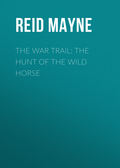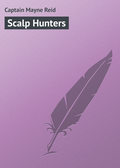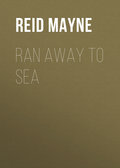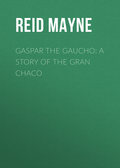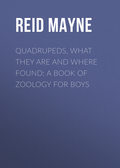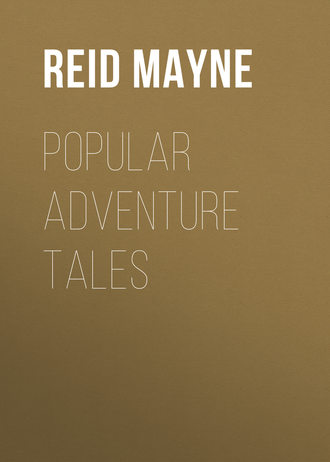
Майн Рид
Popular Adventure Tales
CHAPTER XXXIII.
THE JERFALCON AND THE WHITE GROUSE
“Mine,” began François, “was a bird adventure, as you all see – though what kind of birds I've shot, I can't tell. One of them's a hawk, I'm sure; but it's a white hawk, and that I never saw before. The rest, I suppose, are white partridges. Everything appears to be white here. What are they, Luce?”
“You are right about this first,” answered Lucien, taking up one of the birds which François had brought back with him, and which was white all but a few spots of clove-brown upon its back. “This is a hawk, as you may tell, by its appearance, or rather I should say a 'falcon,' for you must know there is a difference.”
“What difference?” demanded François, with some eagerness of manner.
“Why the principal difference is the formation of their beaks or bills. The bills of the true falcons are stronger, and have a notch in the lower mandible answering to a tooth in the upper one. Their nostrils, too, are differently formed. But another point of distinction is found in their habits. Both feed on warm-blooded animals, and neither will eat carrion. In this respect the hawks and falcons are alike. Both take their prey upon the wing; but herein lies the difference. The hawks capture it by skimming along horizontally or obliquely, and picking it up as they pass; whereas the true falcons 'pounce' down upon it from above, and in a line nearly vertical.”
“Then this must be a true falcon,” interrupted François, “for I saw the gentleman do that very thing; and beautifully he did it, too.”
“It is a falcon,” continued Lucien; “and of the many species of hawks which inhabit North America – over twenty in all – it is one of the boldest and handsomest. I don't wonder you never saw it before; for it is truly a bird of the Northern regions, and does not come so far south as the territory of the United States, much less into Louisiana. It is found in North Europe, Greenland, and Iceland, and has been seen as far north on both continents as human beings have travelled. It is known by the name of 'jerfalcon,' or 'gyrfalcon,' but its zoological name is Falco Islandicus.”
“The Indians here,” interposed Norman, “call it by a name that means 'winter bird,' or 'winterer' – I suppose, because it is one of the few that stay in these parts all the year round, and is therefore often noticed by them in winter time. The traders sometimes call it the 'speckled partridge-hawk,' for there are some of them more spotted than this one is.”
“True,” said Lucien; “the young ones are nearly of a brown colour, and they first become spotted or mottled after a year or two. They are several years old before they get the white plumage, and very few individuals are seen of a pure white all over, though there are some without a spot.”
“Yes,” continued the naturalist, “it is the jerfalcon; and those other birds which you call 'white partridges,' are the very creatures upon which it preys. So you have killed both the tyrant and his victims. They are not partridges though, but grouse – that species known as 'willow grouse.'”
And as Lucien said this, he began to handle the birds, which were of a beautiful white all over, with the exception of the tail feathers. These last were pitch-black.
“Ho!” exclaimed Lucien, in some surprise, “you have two kinds here! Were they all together when you shot them?”
“No,” answered François; “one I shot along with the hawk out in the open ground. All the others I killed upon a tree in a piece of woods that I fell in with. There's no difference between them that I can see.”
“But I can,” said Lucien, “although I acknowledge they all look very much alike. Both are feathered to the toes – both have the black feathers in the tail – and the bills of both are black; but if you observe closely, this kind – the willow-grouse – has the bill much stronger and less flattened. Besides, it is a larger bird than the other, which is 'the rock-grouse.' Both are sometimes, though erroneously, called 'ptarmigan;' but they are not the true ptarmigan – such as exist in North Europe – though these last are also to be met with in the Northern parts of America. The ptarmigan are somewhat larger than either of these kinds, but in other respects differ but little from them.
“The habits of the 'rock' and 'willow' grouse are very similar. They are both birds of the snowy region, and are found as far north as has been explored. The willow-grouse in winter keep more among the trees, and are oftener met with in wooded countries; whereas the others like best to live in the open ground, and, from your statement, it appears you found each kind in its favourite haunt.”
“Just so,” said François. “After leaving here, I kept down the valley, and was just crossing an open piece of high ground, when I espied the white hawk, or falcon as you call it, hovering in the air as I'd often seen hawks do. Well, I stopped and hid behind a rock, thinking I might have a chance to put a few drops into him. All at once he appeared to stand still in the air, and, then closing his wings, shot down like an arrow. Just then I heard a loud 'whur-r-r,' and up started a whole covey of white partridges – grouse, I should say – the same as this you call the 'rock-grouse.' I saw that the hawk had missed the whole of them, and I marked them as they flew off.
“They pitched about a hundred yards or so, and then went plunge under the snow – every one of them making a hole for itself just like where one had poked their foot in! I guess, boys, this looked funny enough. I thought I would be sure to get a shot at some of these grouse as they came out again; so I walked straight up to the holes they had made, and stood waiting. I still saw the hawk hovering in the air, about an hundred yards ahead of me.
“I was considering whether I ought to go farther on, and tramp the birds out of the snow; for I believed, of course, they were still under the place where the holes were. All at once I noticed a movement on the crust of the snow right under where the hawk was flying, and then that individual shot down to the spot, and disappeared under the snow! At the same instant, the crust broke in several places, and up came the grouse one after another, and whirred off out of sight, without giving me any sort of a chance. The hawk, however, had not come up yet; and I ran forward, determined to take him as soon as he should make his appearance. When I had got within shooting distance, up he fluttered to the surface, and – what do you think? – he had one of the grouse struggling in his claws! I let him have the right barrel, and both he and grousy were knocked dead as a couple of door-nails!
“I thought I might fall in with the others again; and kept on in the direction they had taken, which brought me at last to a piece of woodland consisting of birches and willow-trees. As I was walking along the edge of this, I noticed one of the willows, at some distance off, covered with great white things, that at first I took for flakes of snow; but then I thought it curious that none of the other trees had the same upon them. As I came a little nearer, I noticed one of the things moving, and then I saw they were birds, and very like the same I had just seen, and was then in search of. So I crept in among the trees; and, after some dodging, got within beautiful shooting distance, and gave them both barrels. There, you see the result!”
Here François triumphantly pointed to the pile of birds, which in all, with the jerfalcon, counted four brace and a half.
One was the rock-grouse, which the falcon had itself killed, and the others were willow-grouse, as Lucien had stated. François now remained silent, while Basil related his day's adventure.
CHAPTER XXXIV.
THE HARE, THE LYNX, AND THE GOLDEN EAGLE
“Frank,” began he, “has called his 'a bird adventure.' I might give mine somewhat of the same title, for there was a bird mixed up with it – the noblest of all birds – the eagle. But you shall hear it.
“On leaving the camp, I went, as you all know, up the valley. After travelling for a quarter of a mile or so, I came upon a wide open bottom, where there were some scattered willows and clumps of dwarf birch-trees. As Luce had told me that such are the favourite food of the American hare, or, as we call it in Louisiana, 'rabbit,' I looked out for the sign of one, and, sure enough, I soon came upon a track, which I knew to be that of 'puss.' It was fresh enough, and I followed it. It kept me meandering about for a long while, till at last I saw that it took a straight course for some thick brushwood, with two or three low birches growing out of it.
“As I made sure of finding the game there, I crept forward very quietly, holding Marengo in the leash. But the hare was not in the brush; and, after tramping all through it, I again noticed the track where she had gone out on the opposite side. I was about starting forth to follow it, when all at once an odd-looking creature made its appearance right before me. It was that fellow there!” And Basil pointed to the lynx. “I thought at first sight,” continued he, “it was our Louisiana wild cat or bay lynx, as Luce calls it, for it is very like our cat; but I saw it was nearly twice as big, and more greyish in the fur. Well, when I first sighted the creature, it was about an hundred yards off.
“It hadn't seen me, though, for it was not running away, but skulking along slowly – nearly crosswise to the course of the hare's track – and looking in a different direction to that in which I was. I was well screened behind the bushes, and that, no doubt, prevented it from noticing me. At first I thought of running forward, and setting Marengo after it. Then I determined on staying where I was, and watching it a while. Perhaps it may come to a stop, reflected I, and let me creep within shot. I remained, therefore, crouching among the bushes, and kept the dog at my feet.
“As I continued to watch the cat, I saw that, instead of following a straight line, it was moving in a circle!
“The diameter of this circle was not over an hundred yards; and in a very short while the animal had got once round the circumference, and came back to where I had first seen it. It did not stop there, but continued on, though not in its old tracks. It still walked in a circle, but a much smaller one than before. Both, however, had a common centre; and, as I noticed that the animal kept its eyes constantly turned towards the centre, I felt satisfied that in that place would be found the cause of its strange manœuvring. I looked to the centre. At first I could see nothing – at least nothing that might be supposed to attract the cat. There was a very small bush of willows, but they were thin. I could see distinctly through them, and there was no creature there, either in the bush or around it. The snow lay white up to the roots of the willows, and I thought that a mouse could hardly have found shelter among them, without my seeing it from where I stood.
“Still I could not explain the odd actions of the lynx, upon any other principle than that it was in the pursuit of game; and I looked again, and carefully examined every inch of the ground as my eyes passed over it. This time I discovered what the animal was after. Close into the willows appeared two little parallel streaks of a dark colour, just rising above the surface of the snow. I should not have noticed them had there not been two of them, and these slanting in the same direction. They had caught my eyes before, but I had taken them for the points of broken willows. I now saw that they were the ears of some animal, and I thought that once or twice they moved slightly while I was regarding them.
“After looking at them steadily for a time, I made out the shape of a little head underneath. It was white, but there was a round dark spot in the middle, which I knew to be an eye. There was no body to be seen. That was under the snow, but it was plain enough that what I saw was the head of a hare. At first I supposed it to be a Polar hare – such as we had just killed – but the tracks I had followed were not those of the Polar hare. Then I remembered that the 'rabbit' of the United States also turns white in the winter of the Northern regions. This, then, must be the American rabbit, thought I.
“Of course my reflections did not occupy all the time I have taken in describing them. Only a moment or so. All the while the lynx was moving round and round the circle, but still getting nearer to the hare that appeared eagerly to watch it. I remembered how Norman had manœuvred to get within shot of the Polar hare; and I now saw the very same ruse being practised by a dumb creature, that is supposed to have no other guide than instinct. But I had seen the 'bay lynx' of Louisiana do some 'dodges' as cunning as that, – such as claying his feet to make the hounds lose the scent, and, after running backwards and forwards upon a fallen log, leap into the tops of trees, and get off in that way.”
“Believing that his Northern cousin was just as artful as himself” (here Basil looked significantly at the “Captain,”) “I did not so much wonder at the performance I now witnessed. Nevertheless, I felt a great curiosity to see it out. But for this curiosity I could have shot the lynx every time he passed me on the nearer edge of the circle. Round and round he went, then, until he was not twenty feet from the hare, that, strange to say, seemed to regard this the worst of her enemies more with wonder than fear. The lynx at length stopped suddenly, brought his four feet close together, arched his back like an angry cat, and then with one immense bound, sprang forward upon his victim.
“The hare had only time to leap out of her form, and the second spring of the lynx brought him right upon the top of her. I could hear the child-like scream which the American rabbit always utters when thus seized; but the cloud of snow-spray raised above the spot prevented me for a while from seeing either lynx or hare. The scream was stifled in a moment, and when the snow-spray cleared off, I saw that the lynx held the hare under his paws, and that 'puss' was quite dead.
“I was considering how I might best steal up within shooting distance, when, all at once, I heard another scream of a very different sort. At the same time a dark shadow passed over the snow. I looked up, and there, within fifty yards of the ground, a great big bird was wheeling about. I knew it to be an eagle from its shape; and at first I fancied it was a young one of the white-headed kind – for, as you are aware, these do not have either the white head or tail until they are several years old. Its immense size, however, showed that it could not be one of these. It must be the great 'golden' eagle of the Rocky Mountains, thought I.
“When I first noticed it, I fancied that it had been after the rabbit; and, seeing the latter pounced upon by another preying creature, had uttered its scream at being thus disappointed of its prey. I expected, therefore, to see it fly off. To my astonishment it broke suddenly out of the circles in which it had been so gracefully wheeling, and, with another scream wilder than before, darted down towards the lynx!
“The latter, on hearing the first cry of the eagle, had started, dropped his prey, and looked up. In the eagle he evidently recognised an antagonist, for his back suddenly became arched, his fur bristled up, his short tail moved quickly from side to side, and he stood with glaring eyes, and claws ready to receive the attack.
“As the eagle came down, its legs and claws were thrown forward, and I could then tell it was not a bald eagle, nor the great “Washington eagle,” nor yet a fishing eagle of any sort, which both of these are. The fishing eagles, as Lucien had told me, have always naked legs, while those of the true eagles are more feathered. So were his, but beyond the feathers I could see his great curved talons, as he struck forward at the lynx. He evidently touched and wounded the animal, but the wound only served to make it more angry: and I could hear it purring and spitting like a tom-cat, only far louder.
“The eagle again mounted back into the air, but soon wheeled round and shot down a second time. This time the lynx sprang forward to meet it, and I could hear the concussion of their bodies as they came together. I think the eagle must have been crippled, so that it could not fly up again, for the fight from that time was carried on upon the ground. The lynx seemed anxious to grasp some part of his antagonist's body – and at times I thought he had succeeded – but then he was beaten off again by the bird, that fought furiously with wings, beak, and talons.”
“The lynx now appeared to be the attacking party, as I saw him repeatedly spring forward at the eagle, while the latter always received him upon its claws, lying with its back upon the snow. Both fur and feathers flew in every direction, and sometimes the combatants were so covered with the snow-spray that I could see neither of them.
“I watched the conflict for several minutes, until it occurred to me, that my best time to get near enough for a shot was just while they were in the thick of it, and not likely to heed me. I therefore moved silently out of the bushes; and, keeping Marengo in the string, crept forward. I had but the one bullet to give them, and with that I could not shoot both; but I knew that the quadruped was eatable, and, as I was not sure about the bird, I very easily made choice, and shot the lynx. To my surprise the eagle did not fly off, and I now saw that one of its wings was disabled! He was still strong enough, however, to scratch Marengo severely before the latter could master him. As to the lynx, he had been roughly handled. His skin was torn in several places, and one of his eyes, as you see, regularly 'gouged out.'”
Here Basil ended his narration; and after an interval, during which some fresh wood was chopped and thrown upon the fire, Norman, in turn, commenced relating what had befallen him.
CHAPTER XXXV.
THE “ALARM BIRD” AND THE CARIBOU
“There wasn't much 'adventure' in my day's sport,” said he, “though I might call it a 'bird-adventure' too, for if it hadn't been for a bird I shouldn't have had it. I shot a deer – that's all. But maybe it would be curious for you to know how I came to find the animal, so I'll tell you.
“The first thing I did after leaving here was to climb the hill yonder” – here Norman pointed to a long hill that sloped up from the opposite shore of the lake, and which was the direction he had taken, as Basil and François had gone right and left.
“I saw neither bird, beast, nor track, until I had reached the top of the hill. There I got a good view of the country ahead. I saw it was very rocky, without a stick of timber, and did not look very promising for game. 'It's no use going that way,' I says to myself; “I'll keep along the ridge, above where Frank's gone. He may drive some varmint out of the hollow, and I'll get a crack at it, as it comes over the hill.
“I was about to turn to the left when I heard the skreek of a bird away ahead of me. I looked in that direction; and, sure enough, saw one wheeling about in the air, right above the rocky jumble with which the country was covered.
“Now it's a mighty curious bird that I saw. It's a sort of an owl, but, I should say myself, there's a sprinkling of the hawk in it – for it's as much like the one as the other.”
“No doubt,” interrupted Lucien, “it was one of the day owls of these Northern regions, some of which approach very near to the hawks, both in shape and habits. This peculiarity arises from the fact of the long summer day – of weeks in duration – within the Arctic circle, requiring them to hunt for their prey, just as hawks do; and therefore Nature has gifted them with certain peculiarities that make them resemble these birds. They want the very broad faces and large tufted heads of the true owls; besides the ears, which in the latter are remarkable for their size, and also for being operculated, or with lids, in the former are not much larger than in other birds of prey. The small hawk-owl which is altogether a Northern bird, is one of this kind.”
“Very well,” continued Norman, “what you say may be very true, cousin Luce; I only know that the bird I am speaking about is a mighty curious little creature. It ain't bigger than a pigeon, and is of a mottled brown colour; but what I call it curious for is this: – Whenever it sees any creature passing from place to place, it mounts up into the air, and hovers above them, keeping up a constant screeching, like the squalling of a child – and that's anything but agreeable. It does so, not only in the neighbourhood of its nest – like the plover and some other birds – but it will sometimes follow a travelling party for hours together, and for miles across the country.”
From this circumstance the Indians of these parts call it the “alarm bird,” or “bird of warning,” because it often makes them aware of the approach either of their enemies or of strangers. Sometimes it alarms and startles the game, while the hunter is crawling up to it; and I have known it to bother myself for a while of a day, when I was after grouse. It's a great favourite with the Indians though – as it often guides them to deer, or musk-oxen, by its flying and screaming above where these animals are feeding.
Just in the same way it guided me. I knew, from the movements of the bird, that there must be something among the rocks. I couldn't tell what, but I hoped it would turn out to be some creature that was eatable; so I changed my intention, and struck out for the place where it was.
It was a good half mile from the hill, and it cost me considerable clambering over the rocks, before I reached the ground. I thought to get near enough to see what it was, without drawing the bird upon myself, and I crouched from hummock to hummock; but the sharp-eyed creature caught sight of me, and came screeching over my head. I kept on without noticing it; but as I was obliged to go round some large rocks, I lost the direction, and soon found myself wandering back into my own trail.
I could do nothing, therefore, until the bird should leave me, and fly back to whatever had first set it a-going. In order that it might do so, I crept in under a big stone that jutted out, and lay quiet a bit, watching it. It soon flew off, and commenced wheeling about in the air, not more than three hundred yards from where I lay. This time I took good bearings, and then went on. I did not care for the bird to guide me any longer, for I observed there was an open spot ahead, and I was sure that there I could see something. And sure enough I did. On peeping round the end of a rock, I spied a herd of about fifty deer.
They were reindeer, of course, as there are no others upon the 'Barren Grounds,' and I saw they were all does – for at this season the bucks keep altogether in the woods. Some of them were pawing the snow to get at the moss, while others were standing by the rocks, and tearing off the lichens with their teeth. It so happened that I had the wind of them, else they would have scented me and made off, for I was within a hundred yards of the nearest. I was not afraid of their taking fright, so long as they could only see part of my body – for these deer are so stupid, or rather so curious, that almost anything will draw them within shot.
Knowing this, I practised a trick that had often helped me before; and that was to move the barrel of my gun, up and down, with the same sort of motion as the deer make with their horns, when rubbing their necks against a rock or tree. If I'd had a set of antlers, it would have been all the better; but the other answered well enough. It happened the animals were not very wild, as, likely, they hadn't been hunted for a good while. I bellowed at the same time, – for I know how to imitate their call – and, in less than a minute's time, I got several of them within range. Then I took aim, and knocked one over, and the rest ran off. “That,” said Norman, “ended my adventure – unless you call the carrying a good hundred pounds weight of deer-meat all the way back to camp part of it. If so, I can assure you that it was by far the most unpleasant part.”
Here Norman finished his narration, and a conversation was carried on upon the subject of reindeer, or, as these animals are termed, in America, “caribou.”
Lucien said that the reindeer is found in the Northern regions of Europe and Asia as well as in America, but that there were several varieties of them, and perhaps there were different species. Those of Lapland are most celebrated, because they not only draw sledges, but also furnish food, clothing, and many other commodities for their owners. In the north of Asia, the Tungusians have a much larger sort, which they ride upon; and the Koreki, who dwell upon the borders of Kamschatka, possess vast herds of reindeer – some rich individuals owing as many as ten or twenty thousand!
It is not certain that the reindeer of America is exactly the same as either of the kinds mentioned; and indeed in America itself there are two very distinct kinds – perhaps a third. Two kinds are well known, that differ from each other in size, and also in habits. One is the “Barren Ground caribou,” and the other, the “Woodland caribou.” The former is one of the smallest of the deer kind – the bucks weighing little over one hundred pounds. As its name implies, it frequents the Barren Grounds, although in winter it also seeks the shelter of wooded tracts. Upon the Barren Grounds, and the desolate shores and islands of the Arctic Sea, it is the only kind of deer found, except at one or two points, as the mouth of the Mackenzie River – which happens to be a wooded country, and there the moose also is met with.
Nature seems to have gifted the Barren Ground caribou with such tastes and habits, that a fertile country and a genial clime would not be a pleasant home for it. It seems adapted to the bleak, sterile countries in which it dwells, and where its favourite food – the mosses and lichens – is found. In the short summer of the Arctic regions, it ranges still farther north; and its traces have been found wherever the Northern navigators have gone. It must remain among the icy islands of the Arctic Sea until winter be considerably advanced, or until the sea is so frozen as to allow it to get back to the shores of the continent.
The “Woodland caribou” is a larger variety – a Woodland doe being about as big as a Barren Ground buck – although the horns of the latter species are larger and more branching than those of the former. The Woodland kind are found around the shores of Hudson's Bay, and in other wooded tracts that lie in the southern parts of the fur countries – into which the Barren Ground caribou never penetrates. They also migrate annually, but, strange to say, their spring migrations are southward, while, at the same season, their cousins of the Barren Grounds are making their way northward to the shores of the Arctic Sea. This is a very singular difference in their habits, and along with their difference in bulk, form, &c., entitles them to be ranked as separate species of deer.
The flesh of the Woodland caribou is not esteemed so good an article of food as that of the other; and, as it inhabits a district where many large animals are found, it is not considered of so much importance in the economy of human life. The “Barren Ground caribou,” on the other hand, is an indispensable animal to various tribes of Indians, as well as to the Esquimaux. Without it, these people would be unable to dwell where they do; and although they have not domesticated it, and trained it to draught, like the Laplanders, it forms their main source of subsistence, and there is no part of its body which they do not turn to some useful purpose.
Of its horns they form their fish-spears and hooks, and, previous to the introduction of iron by the Europeans, their ice-chisels and various other utensils. Their scraping or currying knives are made from the split shin-bones. The skins make their clothing, tent-covers, beds, and blankets. The raw hide, cleared of the hair and cut into thongs, serves for snares, bow-strings, net-lines, and every other sort of ropes. The finer thongs make netting for snow-shoes – an indispensable article to these people – and of these thongs fish-nets are also woven; while the tendons of the muscles, when split, serve for fine sewing-thread. Besides these uses, the flesh of the caribou is the food of many tribes, Indians and Esquimaux, for most of the year; and, indeed, it may be looked upon as their staple article of subsistence.
There is hardly any part of it (even the horns, when soft) that is not eaten and relished by them. Were it not for the immense herds of these creatures that roam over the country, they would soon be exterminated – for they are easily approached, and the Indians have very little difficulty, during the summer season, in killing as many as they please.
Norman next gave a description of the various modes of hunting the caribou practised by the Indians and Esquimaux; such as driving them into a pound, snaring them, decoying and shooting them with arrows, and also a singular way which the Esquimaux have of taking them in a pit-trap built in the snow.
“The sides of the trap,” said he, “are built of slabs of snow, cut as if to make a snow-house. An inclined plane of snow leads to the entrance of the pit, which is about five feet deep, and large enough within to hold several deer. The exterior of the trap is banked up on all sides with snow; but so steep are these sides left, that the deer can only get up by the inclined plane which leads to the entrance. A great slab of snow is then placed over the mouth of the pit, and revolves on two axles of wood. This slab will carry the deer until it has passed the line of the axles, when its weight overbalances one side, and the animal is precipitated into the pit. The slab then comes back into a horizontal position as before, and is ready to receive another deer. The animals are attracted by moss and lichens placed for them on the opposite side of the trap – in such a way that they cannot be reached without crossing the slab. In this sort of trap several deer are frequently caught during a single day.”



